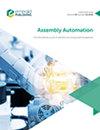应用于超声电机的自适应滑模控制器设计
IF 1.7
4区 计算机科学
Q3 AUTOMATION & CONTROL SYSTEMS
引用次数: 6
摘要
本文的目的是实现无抖振的高精度滑模控制;控制参数易于调整,整个控制器在工程实践中易于使用。设计/方法/方法采用双滑模曲面,可以根据误差信号自适应调整控制信号的增益。设计了一种无抖振的滑模控制器,并将其应用于超声波电机的控制中。结果表明:对于跟踪幅度为35 mm的位置信号,在抖振较小的前提下,传统滑模控制方法的最大跟踪误差为0.3326 mm;边界层滑模控制方法的最大跟踪误差为0.3927 mm,无抖振,连续切换自适应滑模控制的最大跟踪误差为0.1589 mm,无抖振。在相同控制参数下,加入0.5 kg载荷后,传统滑模控制方法、边界层滑模控制方法和连续切换自适应滑模控制的最大跟踪误差分别为0.4292 mm、0.5111 mm和0.1848 mm。提出的方法不仅开关连续,而且开关信号的幅度是自适应的,同时保持了传统滑模控制方法的鲁棒性,具有较强的工程应用价值。本文章由计算机程序翻译,如有差异,请以英文原文为准。
Design of adaptive sliding mode controller applied to ultrasonic motor
Purpose
The purpose of this paper is to achieve high-precision sliding mode control without chattering; the control parameters are easy to adjust, and the entire controller is easy to use in engineering practice.
Design/methodology/approach
Using double sliding mode surfaces, the gain of the control signal can be adjusted adaptively according to the error signal. A kind of sliding mode controller without chattering is designed and applied to the control of ultrasonic motors.
Findings
The results show that for a position signal with a tracking amplitude of 35 mm, the traditional sliding mode control method has a maximum tracking error of 0.3326 mm under the premise of small chattering; the boundary layer sliding mode control method has a maximum tracking error of 0.3927 mm without chattering, and the maximum tracking error of continuous switching adaptive sliding mode control is 0.1589 mm, and there is no chattering. Under the same control parameters, after adding a load of 0.5 kg, the maximum tracking errors of the traditional sliding mode control method, the boundary layer sliding mode control method and the continuous switching adaptive sliding mode control are 0.4292 mm, 0.5111 mm and 0.1848 mm, respectively.
Originality/value
The proposed method not only switches continuously, but also the amplitude of the switching signal is adaptive, while maintaining the robustness of the conventional sliding mode control method, which has strong engineering application value.
求助全文
通过发布文献求助,成功后即可免费获取论文全文。
去求助
来源期刊

Assembly Automation
工程技术-工程:制造
CiteScore
4.30
自引率
14.30%
发文量
51
审稿时长
3.3 months
期刊介绍:
Assembly Automation publishes peer reviewed research articles, technology reviews and specially commissioned case studies. Each issue includes high quality content covering all aspects of assembly technology and automation, and reflecting the most interesting and strategically important research and development activities from around the world. Because of this, readers can stay at the very forefront of industry developments.
All research articles undergo rigorous double-blind peer review, and the journal’s policy of not publishing work that has only been tested in simulation means that only the very best and most practical research articles are included. This ensures that the material that is published has real relevance and value for commercial manufacturing and research organizations.
 求助内容:
求助内容: 应助结果提醒方式:
应助结果提醒方式:


